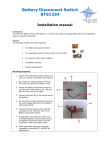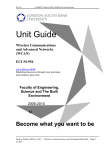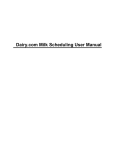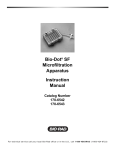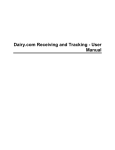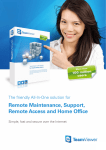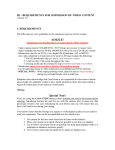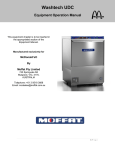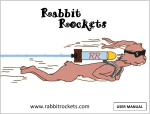Download Freedom Rocker™ BlotBot
Transcript
Operator’s Manual The Freedom Rocker™ BlotBot® Congratulations! Contents Congratulations on your purchase of a Freedom Rocker™ BlotBot® by Next Advance, Inc. We're sure that once you use it, you will never want to process your Western blots manually again. Please read this operator’s manual which explains proper operation of the instrument. This manual is posted on our website, www.nextadvance.com. Click on the SUPPORT button and then on the appropriate link to the manual. We’re confident that your BlotBot will become an essential tool in your laboratory and we wish you success with your work. Parts of the BlotBot.........................2 The BlotBot Work Area .................3 Table of Icons .................................4 Setup................................................5 Operation.........................................5 Programming the BlotBot...............6 After the run ...................................7 Maintenance ...................................7 Troubleshooting..............................8 Support............................................8 Specifications..................................9 Warranty.........................................9 Warnings and Cautions .................10 Disclaimer......................................10 Contact Info...................................11 rev. 15.F12 Operator’s Manual for the Freedom Rocker™ BlotBot® Parts of the BlotBot® Model 120 shown. Model 240 has two windows, work areas and doors on the left and right, and the control panel and display in the center. 1) Display 2) Control Buttons 3) Window Knob 4) Work Area visible through the window 5) Waste tank compartment Caution: Follow the Instructions in the Operator’s Manual Please dispose of the tubes, trays, and BlotBot in accordance with local regulations 2 Operator’s Manual for the Freedom Rocker™ BlotBot® The BlotBot Work Area 1) Antibody (reagent) tubes 2) Wash buffer tubing 3) Rocker cradle 4) Tray cover 5) Sample tray 6) Reagent slider 7) Cover retainer clip 8) Recovery funnel 9) Waste funnel 10) Funnel tray Blots to be processed are placed in the sample tray. The mini blot tray, which has a central divider, can be used for mini blots and strips. Larger blots can be processed using the midi blot tray. The reagent slider positions the antibody (reagent) tubes and the wash buffer nozzles over the sample tray when needed. Waste liquids are dumped into the waste funnel which directs them into the waste tank. Reagents that are to be recovered for reuse are directed into the recovery funnels. The antibody tubes, sample tray, funnel tray, and waste tank are easily removed from the machine for cleaning. Other components are designed to remain in the instrument. 3 Operator’s Manual for the Freedom Rocker™ BlotBot® Table of Icons Accept Fill Back Home Cancel (Stop) Pause Continue Run Drain Save Edit Figure 3: Button icons used on the BlotBot. The functions of particular buttons are explained in the text. 4 Operator’s Manual for the Freedom Rocker™ BlotBot® Western blot protocol (see "Programming the BlotBot", below). SETUP Remove all tape and packing materials from the BlotBot, and place it on a stable, level lab bench. Open the door(s) and remove the funnel tray. Unscrew the caps from the 50 mL recovery tubes and place them in the brackets to each side of the waste tank. Replace the funnel tray and close the door. Open the transparent window that protects the work area (see Figure 2). Place the sample tray into the rocker cradle and fold the flaps over toward the center of the tray. The spikes on the tray should be facing toward the back of the instrument. Place the tray cover onto the sample tray and clamp it down by rotating both of the cover retainer clips. See Figure 2 for reference. The wash buffer connector and the power supply are located at the back of the instrument. Attach the wash buffer hose to the connector using the quickconnect fitting. Plug the power supply into the power jack on the back of the BlotBot and insert the plug into a wall outlet. The machine is now set up. OPERATION Ensure that the window(s) and door(s) are completely closed. Turn the power switch on the back of the unit to the "on" position. The display will illuminate, and the moving parts will return to their home positions. After a few seconds, the home screen will display. Program or select your preferred Fill the buffer bottle. Ensure that the hose hanging from the cap reaches the bottom of the bottle. Leave the cap loose to allow air into the bottle as liquid is pumped out. To fill the buffer hose, select "Flush" from the home screen menu, and press the "Accept" button. The reagent slider will move forward until the buffer dispensing nozzles are over the back of the sample tray. Press the "Fill" button until wash buffer is dispensed from both nozzles. (This may take several seconds.) When the tubing has been filled, press the "Drain" button to remove the dispensed buffer from the sample tray. Check each antibody (reagent) tube to make sure the foil seal is intact and firmly attached. If you are using primary and secondary antibodies, you will need two tubes for each blot you are processing. Screw one tube into the primary antibody position (toward the back of the slider), and the other into the secondary antibody position, just behind the buffer dispensing nozzle. Pour or pipet the appropriate antibody solution or other reagent into each tube. A standard-sized mini blot processed in a mini blot tray requires 3.5 mL of antibody solution per tube, but you may use more reagent if you prefer. Place your blot(s) into the sample tray, along with your blocking buffer or other 5 Operator’s Manual for the Freedom Rocker™ BlotBot® starting reagent or buffer. If you are using a mini blot tray, which has a central divider, make sure the blot is on the same side of the divider as the appropriate antibody tubes, and use no more than 50 mL. of blocking buffer per side. (If you are using a midi blot tray, you may use up to 100 mL. blocking buffer.) Replace the tray cover and fasten it with the retainer clips. Close the waste tray compartment and the work area window. Select the desired protocol from the menu, and press the “Run” button. On the next screen, select which trays will be used for the protocol. Follow the instructions on the screen to enable or disable individual compartments. Disabled compartments will not have buffer dispensed into them. When you are done, press the “Continue” button to proceed. If you have not already done so, check the waste tank to make sure that it is empty, and place 50-ml tubes into the tube holders if you plan to recover antibody. Once this has been done, close the waste tray compartment and press the “Run” button to start the run. PROGRAMMING THE BLOTBOT The BlotBot is designed to work with your own laboratory protocols. To program a new protocol, follow these steps: From the home screen, select "Programs". You will see a list of programs, which have been populated with default values. Select one of the programs using the dial, and press the "Edit" button to edit the program. Step 1: Choose a name for your protocol. Select letters by turning the dial, and press the dial to switch between letters and numbers/symbols. Use the cluster of four buttons at the lower left of the screen to navigate back and forth between letters, and to delete letters or add spaces. When finished, press the “Save” button to save your program name, and then press the “Continue” button to move to the next screen. Step 2: On this screen, select whether the protocol will be used with a mini blot tray (2 chambers with a central divider), or a midi blot tray (one large chamber). If you typically run mini blots, use the mini blot tray even if you plan to run only one blot at a time: it will save reagents. Press the “Save” button, and then press the “Continue” button to move to the next screen. Step 3: Now, choose whether you want a clearing rinse to be included in the protocol. A clearing rinse will briefly rinse the blot with 10 mL. of wash buffer at the end of each step. If you want a clearing rinse, highlight "Enable" on the screen and then press the "Save" button. Press the "Continue" button to continue. 6 Operator’s Manual for the Freedom Rocker™ BlotBot® Step 4: On the last screen, input the times and reagents for each step in your protocol. Buffer wash steps can be repeated up to 10 times, but reagent steps cannot be repeated. When selecting the reagent, you can choose the following: Buffer A; Buffer B; Reagent 1; Reagent 2; and END. Selecting “END” indicates that there are no more steps. For example, a program with 6 steps, whereby for step 1 the blocking solution is already in the tray, may have the reagents set as follows. STEP 1 STEP 2 STEP 3 STEP 4 STEP 5 STEP 6 STEP 7 REAGENT -----BUFFER A REAGENT 1 BUFFER A REAGENT 2 BUFFER B END You should also indicate whether you want your antibody solutions to be recovered for future use. The BlotBot 120 can recover one reagent, and the BlotBot 240 can recover up to two reagents. Recovered reagents will be diverted to the tubes held in the brackets on either side of the waste tank. If you do not plan to recover any reagents, you may set all reagent steps to "Waste". AFTER THE RUN Once the run is complete, press the "Home" button to stop the rocker and return to the home screen. Open the window and remove the sample tray. The blot is now ready for downstream processing (chemiluminescent or colorimetric detection, etc.) The sample tray and cover can be washed using a gentle laboratory detergent. Remove the reagent dispensing tubes from the machine. The tubes may be discarded, or washed for reuse. If you choose to reuse them, remove the foil seals and wash the tubes with detergent. Before re-use, allow the tube to dry completely and seal the bottom with another foil seal. Packets of tubes and seals are sold separately. If you will not be using the BlotBot again for a few days, you may wish to flush the buffer line with distilled water. To do this, place the wash buffer hose into a container of water and use the "Flush" function to run water through the line and into the tray. MAINTENANCE Calibration. The pumps that deliver wash buffer to the tray have been calibrated at the factory. If you want to check or recalibrate the pumps, use the "Calibration" function to do so. From the home screen, select "Maintenance". The on-screen instructions will guide you through the calibration process, which is described briefly below. You will require a graduated cylinder (100 – 200 mL) to perform the calibration. Before you calibrate the pumps, confirm that the wash buffer line is completely full of liquid. If there are bubbles in the line, use the "Flush" function (described above) to remove them. 7 Operator’s Manual for the Freedom Rocker™ BlotBot® The display screen protector, the work area window, and the interior surfaces of the BlotBot can be wiped down as needed with water and a laboratory wipe. Use of alcohol is not recommended, as it may fog some of the plastic surfaces over time. TROUBLESHOOTING Open the waste compartment and remove the funnel tray. If you are using a larger graduated cylinder and need extra room, you may remove the waste tank as well. Place the graduated cylinder under the left-hand buffer nozzle, and press the "Fill" button to dispense liquid into the cylinder. The pump will dispense approximately 40 mL. Once the pump has stopped running, measure the actual amount of liquid dispensed, and enter the value using the encoder knob. Measure the volume from the right-hand nozzle the same way, and record its value. Press the "Save" button to save the values. The pumps are now calibrated. Replace the waste tank and funnel tray and close the waste compartment. General cleaning. Rinse the waste tank and funnel tray when desired. The components are made from reagents that are resistant to chemicals typically used in a Western blot, but some of the components of blocking buffers (nonfat dry milk, BSA, etc) can form unattractive deposits on the surface. In addition to the tips given below, a list of troubleshooting tips is available at http://www.nextadvance.com. If the BlotBot doesn’t start, the plug of the power supply cord may not be in a live wall outlet or the power supply connector may not be fully inserted in the socket on the back of the BlotBot. If the unit stops working, turn the system off for one minute to allow the electronics to reset. If the BlotBot does not turn on after this period, contact customer service. If the unit stops during a run and displays an error message, the run will resume once the error is fixed. The most common error is that the cover or waste compartment have not been fully closed. If the unit has lost power because it was unplugged, or because there was a power outage, simply restore power to the unit when possible. If a run was in progress, it will automatically re-start at the point it had reached when power was lost. You do not need to take any special measures. If the antibodies are not being dispensed, ensure that the spikes on the sample tray are facing toward the back of the instrument, and that they are still sharp. The BlotBot ships with several 8 Operator’s Manual for the Freedom Rocker™ BlotBot® trays. Replacement trays are available for purchase. If buffer is not being dispensed during the run, check to make sure that the end of the buffer hose is resting in the bottom of a full bottle of buffer. The bottle cap should also be slightly loose in order to allow air to flow into the bottle. If the buffer supply is adequate, use the Flush function to diagnose the difficulty. The pumps should be audible as soon as the "Fill" button is pressed; if they are not, call customer support. If the pumps are running but no liquid is dispensed, make sure the buffer nozzles have not become clogged with dried salts or detergent. SUPPORT FAQs, protocols, and other helpful information are available on our website, http://www.nextadvance.com. Click on the Freedom Rocker BlotBot, then on the appropriate link. If you would like further assistance, contact customer service by email at support @nextadvance.com or by telephone at 1.518.674.3510. SPECIFICATIONS BlotBot 120 BlotBot 240 Width 45 cm (17.5 in.) 54 cm (21.5 in) Depth 36 cm (14 in.) 39 cm (15.5 in) Height 46 cm (18 in.) 43 cm (17 in) Weight 17 kg (38 lb.) 15 kg (32 lb.) 2 mini blots or 1 midi blot 4 mini blots or 2 midi blots 1 1 Capacity Blots Buffers Buffer volume Midi blot tray: 150 mL Mini blot tray 75 mL per side Reagents dispense 2 recover 2 dispense 2 recover 2 Maximum reagent 50 mL each 50 mL each Minimum reagent per blot Midi blot tray: 7 mL, 6 mL can be recovered Mini blot: 3.5 mL per blot, 3 mL can be recovered Protocol steps 9 9 Washes per step 10 10 5 to 40, independent for each step 5 to 40 independent for each step Rocks per minute 9 Operator’s Manual for the Freedom Rocker™ BlotBot® Power Requirement: 12 VDC, 2.1 Amp Relative Humidity: 5 – 90% non condensing Operating Temperature: 4 - 40°C Altitude: <2000m Storage Temperature: -40 to 50°C WARRANTY Next Advance warrants its Products against defects in materials and workmanship for time periods which vary according to the Product. Within these time periods, Next Advance will replace or repair, without charge to the original purchaser, any part which is defective. BlotBot warranty = Two years The warranty is void if the Product is defective due to product accident, product modification, exposure to radiation other than for sterilization, connection to an improper electrical supply, lack of proper maintenance, contamination, improper installation or misuse. If the product is used in a manner not specified by the manufacturer, the protection provided by the equipment may be impaired. The warranty shall also not apply to defects arising from fire, flood, lightning or other conditions unrelated to correct operation of the Product. Next Advance’s liability is limited, at the company’s election, to (1) refund of the original purchaser’s purchase price for the Product (2) repair of the Product, or (3) replacement of the Product or defective parts. Evidence of purchase by the original purchaser is required. Next Advance may also request documentation of proper maintenance, if applicable. Next Advance makes no other warranty, expressed or implied, with respect to its Products. NEXT ADVANCE MAKES NO WARRANTY RESPECTING THE MERCHANTABILITY OF THE PRODUCTS OR THEIR SUITABILITY OR FITNESS FOR ANY PARTICULAR PURPOSE OR USE. Next Advance shall not be liable for indirect, special, incidental or consequential damages of any nature. Any recovery for any claim shall be limited to the original purchase price for the product. OPERATOR’S RESPONSIBILITY Provide proof of purchase and provide normal care and maintenance. WARNINGS AND CAUTIONS Read the user’s manual before operating. Do not open the window when the BlotBot is in use. Use recommended accessories only. Substitutions may result in unsatisfactory performance. Do not remove any panels or screws. No user serviceable parts are behind the panels. For indoor use only. Pollution Degree 2 per EN 61010-1. Overvoltage Category II per EN 610101.Enclosure Protection: Not Protected Against the Ingress of External Moisture. Do not immerse in liquid. 10 Operator’s Manual for the Freedom Rocker™ BlotBot® DISCLAIMER Next Advance, Inc. makes no representations or warranties, expressed, statutory or implied, regarding the fitness or merchantability of this product for any particular purpose. In no event shall Next Advance be liable for incidental or consequential damages. Next Advance, Inc. is not liable for any damages, including but not limited to, lost profits, lost savings, or other incidental or consequential damages arising from ownership or use of this product, or for any delay in the performance of its obligations under the warranty due to causes beyond its control. Next Advance, Inc. also reserves the right to make any improvements or modifications to the product described in this manual at any time, without notice of these changes. Next Advance, Inc. products are not designed, intended, or authorized for use in applications or as system components intended to support or sustain human life, as a clinical medical device for humans, or for any application in which the failure of the product could create a situation where personal injury or death may occur. All brand and product names used in this manual are the trademarks of their respective owners. CONTACT INFO Next Advance, Inc. Averill Park, NY, USA Telephone 518-674-3510 www.nextadvance.com Email: [email protected] 11












